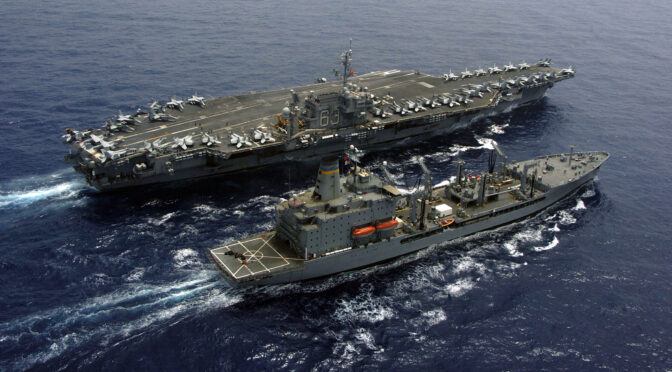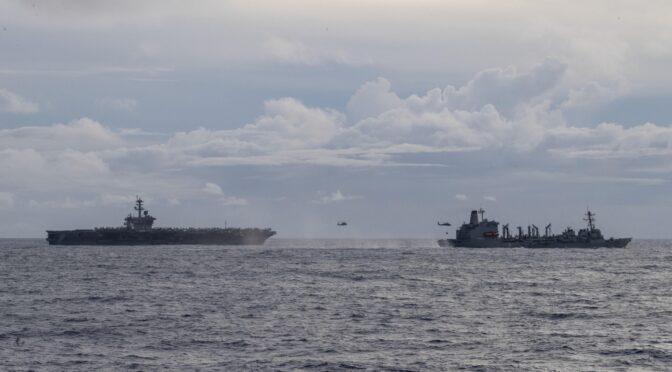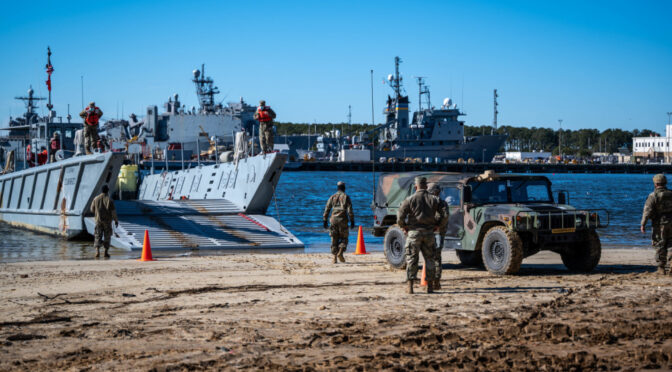By Dmitry Filipoff
For the past two weeks, CIMSEC featured writing sent in response to our call for articles on strategic sealift, issued in partnership with U.S. Transportation Command (USTRANSCOM). The response we received was outstanding and illuminating.
American military power remains heavily dependent on sealift to surge and sustain significant operations. Yet sealift is under significant strain. From aging vessels to manning shortfalls, the overall readiness and capacity of the sealift fleet is far from ideal. Authors put forth innovative concepts to mitigate shortfalls and improve sealift capability. But whether there is enough funding and flexibility to implement some of these solutions remains an open question. What is more clear is that sealift will be indispensable in any great power conflict, and will be a prime target of interest for any adversary seeking to slash U.S. strategic- and operational-level maneuver.
Below are the authors and their articles that featured during the topic week. We thank them for their excellent contributions.
“The Fourth Arm of Defense: America’s Merchant Mariners,” by James Caponiti
“Throughout American history, the one constant has been that a strong commercial maritime capability enhances national security. This is as true today as ever. The Maritime Security Program remains the most important of the federal programs that assist U.S.-flag ships in foreign trade, and it should be supported, fully funded, and modified as necessary to keep pace with economic conditions affecting U.S.-flag shipping.”
“Across the Expanse: The Sealift Dilemma in a War Against China,” by Major John Bowser, U.S. Army
“While the MSC and MARAD aim to ensure the U.S. military is prepared to win expeditionary warfare, they feature critical vulnerabilities with respect to competition with China. The DoD’s critical sealift vulnerabilities against China include fuel distribution capacity, operational security, and vulnerability to partnerships to establish seaports of debarkation and fleet logistics centers. By focusing on these areas DoD will become more able to prosecute expeditionary conflict against China should the need arise.”
“Obsolescence, Chokepoints, and the Maritime Militia: Facing Primary Threats to U.S. Sealift,” by Nicholas Ayrton and Brandon Walls
“Challenges USTRANSCOM could face in this regard are threefold—the aging and inadequate nature of the American sealift force, the vulnerability of said forces to strategic chokepoints in the event of conflict, and the versatility and strength of the Chinese People’s Armed Forces Maritime Militia (PAFMM).”
“Recapitalizing Strategic Sealift Should Be DoD’s Number One Modernization Priority,” by Dr. Daniel Goure
“It is difficult to overstate the dependence of the U.S. military on strategic sealift to both reach the fight and sustain itself during a crisis or conflict. Personnel and some critical equipment and supplies can be moved by aircraft. But for any major deployment overseas, much less a high-end conflict, the U.S. military is and will remain dependent on sealift.”
“American Strategic Sealift in Peer-to-Peer Conflicts: A Historical Retrospective, Pt. 1,” by Salvatore R. Mercogliano, Ph.D.
“…should the United States become engaged in another peer-to-peer conflict, they may lack the requisite sealift, merchant marine, and maritime industrial base to support the Department of Defense. Current plans include a sealift recapitalization scheme that provided funds for two used ships last year, and five more this year, but none have yet to be purchased. The current situation is unsustainable. An examination of the past can provide some alternatives and solutions to the current dilemma the United States finds itself in.”
“For a Greener, More Lethal Force, Look to Strategic Sealift Recapitalization,” by Joshua Tallis and Ronald Filadelfo
“A greener merchant fleet, enabled by technology developed during the recapitalization of the aging sealift fleet (the vessels that bring US troops and materiel to foreign shores) would address an important source of climate change and increase the sustainment reach of the logistics fleet (the auxiliary vessels that keep warships on station). Such a maritime green revolution might even improve lethality.”
“Solutions to Revitalizing America’s Strategic Sealift,” by Todd M. Hiller, P.E.
“With a bi-polar hegemonic world, the U.S. needs to take an immediate and serious deep dive into guaranteeing commercial cargoes for U.S.-flag carriers. This is not a new idea, but one worth revisiting. This proposal, if enforced by treaty or legislation, would have negligible impact on shippers while significantly improving the capacity and number of both the U.S.-flag fleet and U.S.-mariners.”
“American Strategic Sealift in Peer-to-Peer Conflicts: A Historical Retrospective, Pt. 2,” by Salvatore R. Mercogliano, Ph.D.
“The challenge for the United States in a fourth peer-to-peer conflict would be the same in the previous three: to ensure that there was a requisite force of merchant ships to support their maritime strategy…based on history, it appears that the United States is ill-prepared to sustain a large military force overseas, across a contested sea. “
“One Fleet, One Fight: Four “Fs” to Give About Sealift,” by Benjamin Clark and Gregory Lewis
“MSC’s ships are too big and too tired – and those are the ships that work, but they must fight with the fleet they have, not the fleet they want. It is time for Congress and the Defense Department to build a sealift force capable of handling the multiplicity of challenges presented in competition, crisis, and conflict by giving MSC warfighters, a fleet, fuel, flexibility, and friends.”
“Sealift Forces for the Future Operating Environment: An Airlifter’s Perspective,” by Phillip Amrine
“…no one can deny that the environment in which U.S. forces operate is fluid and unpredictable; counting on the threats to remain at their current level would be both foolish and irresponsible. As the long arm of American military power, USTRANSCOM must have the capability to deliver forces anywhere in the world at lightning speed. Maintaining this capability means deliberately monitoring competitors’ capabilities and countering them when they threaten the ability to deploy military force.”
“Strategic Sealift is Broken: Which Direction Are We Headed?” by David Sloane
“It is very clear that the current model is not working. The continued use of the current model will only lead to a fleet that is less ready with fewer mariners who are capable of operating and maintaining this critical defense capability. A change in direction must be made soon and the clock is ticking.”
“Beyond MSC and Amphibs: Unconventional Sealift,” by Benjamin DiDonato
“…warships can provide sealift support for EABO forces. This would naturally have to fit in with other tasking for these ships, so it generally won’t provide predictable resupply, especially when using high-demand assets, but it would still provide additional sealift capacity at essentially no cost.”
“Strategic Sealift’s Merchant Mariner Problem,” by Geoffrey Brown
“Rear Adm. Buzby stated publicly that the Merchant Marine is at least 1,800 officers short of what would be necessary in wartime. Furthering the problem is the lack of places on a dwindling number of ships, leaving 1,100 merchant marine academy graduates worrying about their future job prospects. Given that the average age of a merchant mariner is 47, it is clear that this manpower problem will only get worse if left alone.”
“Don’t Overlook the Medical Fleet in Distributed Maritime Operations,” by Misty Wilkins
“The medical fleet is often overlooked in discussions about Distributed Maritime Operations (DMOs). The goal of DMO is to keep warships in the fight and use all available means necessary to prevail in a modern conflict against a near-peer adversary. But what happens when all available means are simply not enough and fleet assets suffer losses? How will the U.S. Navy get personnel out of the water, into the appropriate medical care, and back in the fight when faced with an impermissible environment and large numbers of potential casualties?”
“The Future of Sea Basing for U.S. Army Transportation,” by Mike Canup, Tim Fitzgerald, and Tim Owens
“Shrinking the gap between early entry forces and the buildup of more robust forces will require the Army to develop innovative approaches to surface and vertical sea basing connectors. Doing so will allow US forces to seize, maintain, and exploit the initiative.”
“The Glutted Mariner Shortfall,” by LCDR Adena Grundy
“From the perspective of the individual U.S. mariner seeking a reliable career path, there is no real shortfall. Within the economically-driven mariner job market, there is actually a glut of mariners in the current workforce, especially in the officer ranks. Without recognizing this current condition, attempts to increase pool size could initiate a vicious circle of issues that will actually drive people from the Merchant Marine, thereby exacerbating the problem.”
“Clandestine Cargo: Hiding Sealift in Plain Sight,” by Christian Morris and Heather Bacon-Shone
“Secretly loading containerized military equipment among the millions of TEUs processed annually at key U.S. ports such as Los Angeles/Long Beach, New York/New Jersey, Houston/Galveston, and Savannah could help military sealift hide in plain sight.”
Dmitry Filipoff is CIMSEC’s Director of Online Content. Contact him at [email protected].
Featured Image: USS KITTY HAWK, Pacific Ocean, (June 26, 2008) The aircraft carrier USS Kitty Hawk (CV 63) receives fuel from USNS Guadalupe (T-AO 200) while steaming through the central Pacific Ocean. (U.S. Navy photograph by Mass Communication Seaman Anthony R. Martinez)





